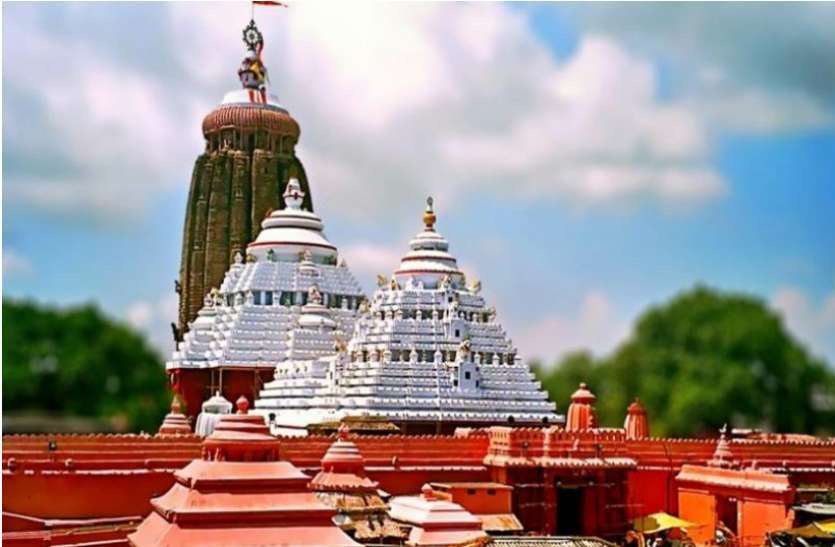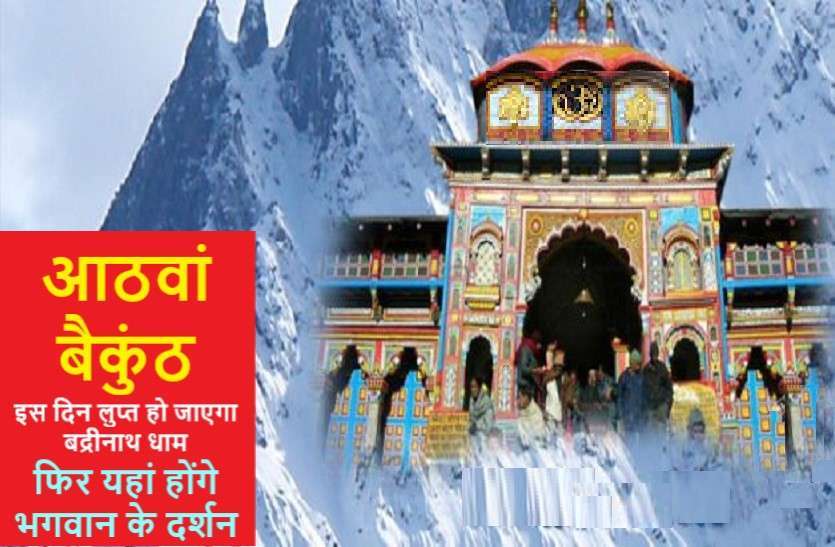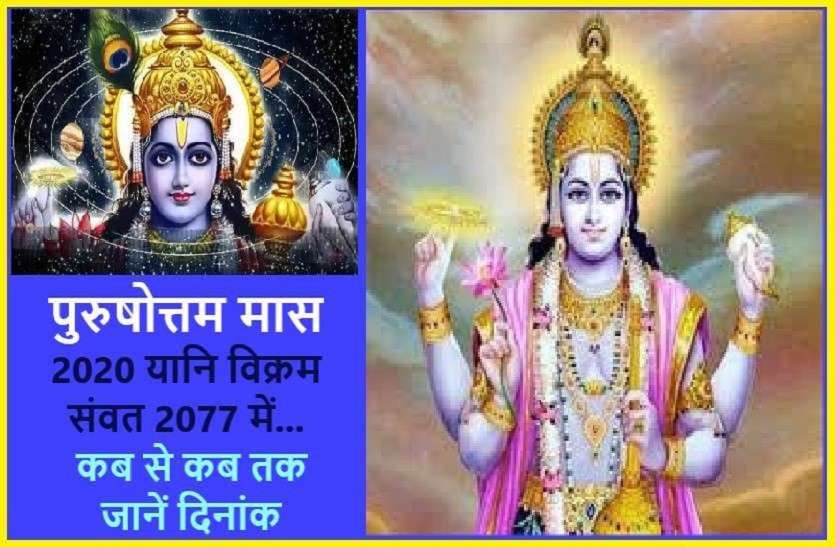The journey of Lord Jagannath, who left the Jagannath temple, having given many indications during the Corona period, will not come out this year i.e. in 2020. There is a huge temple of Lord Jagannath in the coastal city of Puri in the Indian state of Odisha. Jagannath temple is considered one of the Char Dham in Hinduism. Every year a grand Rath Yatra of Lord Jagannath is taken out, which is world famous not only in India. Jagannathpuri is mainly known as Puri. Jagannath Rath Utsav is a 10-day festival during which lakhs of devotees reach here from all over the country.
At the same time, for the first time this year, fire is happening on the summit of Jagannath temple, apart from this, the events are seen as a gesture of Lord Jagannath itself.
The Jagannath Temple at Puri is one of the four sacred shrines in India. The present temple is more than 800 years old, in which Lord Shri Krishna is enthroned in the form of Jagannath. Also, his elder brother Balarama (Balabhadra or Baldev) and his sister Goddess Subhadra are worshiped here.

Story of Jagannath Temple: How to understand the journey…
It is said that the chariot of Jagannathji’s incarnation of Lord Krishna is like a hundred yagyas. Its preparation begins with the creation of chariots of Sri Krishna, Balarama and Subhadra on the day of Akshaya Tritiya. The story of the commencement of the rath yatra tells that King Indradyum lived near Nilanchal Sagar (Orissa) with his entire family.
Once he saw a giant wood in the sea. Then he decided to get Vishnu idol constructed from him. At the same time, he also saw an old carpenter who was none other than Vishwakarma himself.
Lord Vishwakarma, a carpenter, told the king that he would make an idol, but he has one condition. The king asked what condition? Then he said that no one will come in the house where I will make the idol until the idol is completely built. The king accepted this condition with pleasure.
He is said to have engaged in the construction of the idol inside a house near the present place where Sreejagannathji’s temple is located. The family of the king was not aware of the carpenter’s condition.
MUST READ : Eighth Baikunth Badrinath will be lost – know when and how! Then the future will be here …

According to the story, the queen thought that the door was closed for many days and the carpenter would also be hungry. Something has happened to him somewhere. Thinking this, the queen said to the king, please open the door and have the old carpenter take refreshments. On hearing this, the king also forgot his condition and ordered him to open the door. It is said that the old carpenter could not be found anywhere when the door opened. But there they found wooden statues of Sreejagannath, Subhadra and Balarama.
According to the legend, the king and queen were deeply saddened by seeing incomplete idols. But at the same time both of them heard the Akashwani, ‘Don’t be sad in vain, we want to remain in this form, so make the idols consecrated with material etc. and get them installed.’ Even today, those incomplete and obscure idols are embellished and revered in Purushottam Puri’s Rath Yatra and Mandir.
It is believed that Sri Krishna and Balarama performed the rath yatra by sitting in separate chariots with a view to fulfill Mata Subhadra’s desire to visit Dwarka. Since then, this Rath Yatra is organized every year in Puri to commemorate the city tour of Mata Subhadra.
The glory of being involved in a rath yatra…
Rath Yatra is a festival in which Lord Jagannath walks among his devotees and participates in their grief. Its importance is also mentioned in the scriptures and the Puranas. In the Skanda Purana it is clearly stated that whoever joins the Rath Yatra goes to Gundicha Nagar.
He is freed from the cycle of life and death. At the same time, the devotees who visit Sreejagannathji, bowing and passing through the dust and mud of the path, go directly to the best abode of Lord Shri Vishnu. Apart from this, those who see Sri Krishna, Balarama and Subhadra Devi, who are seated on the chariot in the Gundicha Mandap, come to the south.
Importance of Jagannath Rath Yatra
Jagannath Rath Yatra has a great importance in Hinduism. According to the beliefs, Lord Jagannath is taken out of the Rath Yatra to the famous Gundicha Mata Temple. Here Lord Jagannath rest.
Massive preparations are made at Gundicha Mata temple and water is brought from the Indradyuman lake to clean the temple. The greatest significance of the yatra is that it is celebrated like a festival all over India. Jagannath temple is considered one of the Char Dham. Therefore, there is a mention in the scriptures about joining this journey once in life.
MUST READ : Purushottam month 2020 when – know what to do and what not to do in the month of …

At the forefront of the Jagannath Rath Yatra is the chariot of Lord Balabhadra, in the middle is the chariot of Lord Subhadra, the sister of Lord Jagannath. Anyone who is truly involved in this journey, fulfills his desire and attains salvation.
Those who join the yatra get yagya equal to virtue-
Lord Jagannath is considered an incarnation of Shri Krishna. Whose glory is also mentioned in religious texts and Puranas. It is believed that the Jagannath rath yatra consists of the chariots of Lord Krishna and his brother Balarama and sister Subhadra. Those who join this rath yatra and pull the chariot get a virtuous benefit equal to a hundred yagyas.
Lakhs of people join during the Rath Yatra and it takes a huge influx of devotees to pull the chariot. Jagannath Yatra is done on the second date of Shukla Paksha of Ashadha month according to Hindu Panchag. Which was to come out on 23 June this year, which has been stayed by the Supreme Court this year.
History of Jagannath Rath Yatra
Rath Yatra of Lord Jagannath is celebrated like a festival in the country, so in addition to Puri, this journey is carried out in many places. There are many beliefs and history about the Rath Yatra. It is said that one day Lord Jagannath’s sister Subhadra, while wishing to see the city, prayed to God to see Dwarka, then Lord Jagannath made his sister sit in a chariot and tour the city. After which Jagannath Rath Yatra is taken out here every year. In this journey the idols of Lord Jagannath, his brother Balarama and sister Subhadra are kept and they are given a tour of the city.
The three chariots of the yatra are made of wood, which the devotees pull and walk. Lord Jagannath’s chariot consists of 16 wheels and brother Balaram’s chariot has 14 wheels and sister Subhadra’s chariot has 12 wheels. The journey is described in Skanda Purana, Narada Purana, Padma Purana, Bahm Purana etc. That is why this journey is considered very important in Hinduism.
Some special and interesting things related to Lord Jagannath’s Rath Yatra …
: Jagannath Temple in Puri is one of the four sacred shrines of India. The present temple is more than 800 years old, in which Lord Shri Krishna is enthroned in the form of Jagannath. Also, his elder brother Balarama (Balabhadra or Baldev) and his sister Goddess Subhadra are worshiped here.
: For Puri Rath Yatra three different chariots are built for Balarama, Shri Krishna and Goddess Subhadra. The rath yatra leads Balramji’s chariot, followed by the chariot of Goddess Subhadra in the middle and the chariot of Lord Jagannath Sri Krishna at the back. It is identified by their color and height.
: Balaramji’s chariot is called ‘Taladhwaj’, whose color is red and green. The chariot of Goddess Subhadra is called ‘Darpadalan’ or ‘Padma Rath’, which is black or blue and red, while Lord Jagannath’s chariot is called ‘Nandighosh’ or ‘Garudadhwaj’. Its color is red and yellow.
: The Nandigosh chariot of Lord Jagannath is 45.6 feet high, the Taladhwaja chariot of Balramji is 45 feet high and the Darpadalan chariot of Goddess Subhadra is 44.6 feet high.
: All the chariots are made from the pure and mature wood (wood) of neem, which is called ‘Daru’. For this, a healthy and auspicious tree of neem is identified, for which the Jagannath temple constitutes a special committee.
: There is no use of any kind of nail or fork or any other metal in the manufacture of these chariots. The selection of wood for chariots begins on the day of Basant Panchami and their construction begins with Akshaya Tritiya.
: When the three chariots are ready, then a ritual called ‘Chhar Pahanra’ is performed. Under this, the Gajapati king of Puri comes here in the palanquin and duly worships these three chariots and cleans the chariot pavilion and the way with a ‘golden broom’.
: The rath yatra begins on the second date of the bright half of Ashada month. Devotees pull these chariots between drums, drums, trumpets and conch shells. It is said that those who get the opportunity to pull the chariot are considered to be great fortune. According to mythological belief, the chariot puller attains salvation.
: Rath Yatra starts from Jagannath temple and passing through Puri city, these chariots reach Gundicha temple. Here Lord Jagannath, Balabhadra and Goddess Subhadra rest for seven days. The darshan of Lord Jagannath in the Gundicha temple is called ‘Aadap-Darshan’.
: Gundicha Temple is also known as ‘Gundicha Bari’. It is the home of God’s aunt. There is a mythological belief about this temple that it was here that Devashilpi Vishwakarma built the idols of Lord Jagannath, Balabhadra and Devi.
: It is said that on the third day of Rath Yatra i.e. on the fifth day, Goddess Lakshmi comes here looking for Lord Jagannath. The dvaitapati then closes the door, causing Goddess Lakshmi to get angry and break the wheel of the chariot and return to a locality called ‘Hera Gohiri Sahi Puri’ where the Goddess Lakshmi’s temple is.
: Later, there is a tradition of celebrating the goddess Lakshmi by Lord Jagannath. It is conducted through man-manouval dialogues, which produce a wonderful devotional rasa.
: On the tenth day of Ashada month all the chariots again go towards the main temple. The ritual of this journey of return of chariots is called Bahuda Yatra.
: Even after reaching back to the Jagannath temple, all the statues remain in the chariot. The temple gates for the Gods and Goddesses are opened the next day on Ekadashi, then duly bathed, the Deities are reclaimed amidst Vedic hymns.
: Actually the Rath Yatra is a community ceremonial festival. On this occasion, there is no worship in the houses nor any fast is kept. One important thing is that during the Rath Yatra, there is no caste discrimination.
Supreme Court prohibits: understand the whole matter like this …
Due to the corona virus epidemic, the Supreme Court has banned the historic annual Jagannath Puri Rath Yatra, to be held on 23 June. While hearing the matter on Thursday, a bench of Chief Justice SA Bobde, Justice Dinesh Maheshwari and Justice AS Bopanna said that the Rath Yatra cannot be allowed this year in view of public interest and safety of the people.
The Chief Justice said, “If we allow the Rath Yatra this year, Lord Jagannath will not forgive us. There may not be such a large gathering during the epidemic. “The bench also asked the Odisha government not to allow travel, pilgrimage or related activities anywhere in the state to prevent the spread of corona virus.
In view of the corona virus epidemic, an NGO named Odisha Development Council had filed a petition in the Supreme Court and this year sought a stay on the Rath Yatra. Rath Yatra is organized every year in Puri with great fanfare. Programs related to this last for 10-12 days and lakhs of devotees from all over the world participate in it.
Worship was not done for 144 years…
This is the first time in 284 years that Jagannathpuri’s Rath Yatra will not be carried out. But let us tell you that according to the temple records, the temple remained closed for 144 years in the year 2504 due to the invaders. At the same time, the traditions related to the pooja were also closed. But Adi Shankaracharya resumed these traditions. However, since then, all the traditions of the temple have been duly followed in every circumstance.
cow
flute
gem
Jagannath Puri Rath Yatra
Jagannath Rath yatra
jagannath rath yatra 2020
jagannath temple
Lord Jagannath
Lord Jagannath Rath Yatra
Lord Jagannath Rath Yatra Orissa
Lord Jagannath Rathyatra
Lord Shri Krishna
peacock feather
Pitambar
Puri Jagannath
puri Jagannath Rath Yatra
Puri Rath yatra
Rath Yatra
Rath Yatra Festival
rathyatra
Religion
sandal
Sudarshan chakra
Supreme Court
wood
Sandalwood
Dwarka
Puri
flute
Lord Shri Krishna
Peacock feather
Chariot Festival
Sudarshan Chakra
Subhadra
[ad_1]
[ad_2]
